|
Hot water cylinder terminology |
|
| |
| You may find the terminology used to
describe a hot water cylinder a little confusing.
Direct....
Indirect.... Combination..... Solar.... What does this mean? Click on
your question below -
|
| |
|
|
Know enough? |
|
If you feel
comfortable with the terminology and wish to make a product
selection click on the button below to go to the cylinder
page.... |
| |
|
 |
|
|
| 1. |
Categories of Hot Water
Cylinder |
| 2. |
|
| 3. |
|
| 4. |
|
| 5. |
|
| 6. |
|
| 7. |
|
| 8. |
|
| 9. |
|
....It all depends where the
cylinder gets it's heat from.
Please note:
Information contained on this page is intended to assist with your
understanding of cylinders and terminology. It does not represent a definitive
description of each and every product available. If in any doubt, please call
for assistance - we will be pleased to help.
|
|
Categories of hot water cylinder |
There are several
categories of cylinder that can be split into types. To simplify matters we
will firstly deal with Category.
- Vented
- Unvented
- Thermal store
The category depends on how you intend to
supply cold water to the cylinder which in turn will determine what you can
expect in the way of performance from the cylinder.
There are essentially two methods of
supplying water to a cylinder...
- Directly from the incoming cold water
main - known as a mains pressure supply
- From a holding tank (also known as a
Cistern, Header Tank or Storage tank) - known as a gravity supply
It is most important that you never connect
a cylinder designed for a gravity supply to a mains pressure supply. To do
so is highly dangerous and the risk of explosion exists.
The only type of cylinders you may connect
directly to a mains pressure supply are the Unvented Type and Thermal
Stores. Both of these are designed to handle the higher pressures associated
with a mains supply and will deliver mains pressure hot water - albeit is
slightly different ways.
Unvented cylinders: These are
essentially pressure vessels. You fill them with water at constant mains
pressure, heat the contents (by whatever means) and when you open a tap the
incoming pressure forces the contents (hot water) out - hence mains pressure
hot water.
Thermal Stores: Deliver mains
pressure hot water but achieve the same result in a different way. A thermal
store could be likened to a large bucket. The water in the bucket is heated
by whatever means. By immersing a heat exchanger in the bucket and passing
mains pressure water through it the heat from the water in the bucket is
transferred to the water passing through the heat exchanger, which emerges
as it leaves the thermal store as mains pressure hot water.
The advantage of a Thermal Store over an
Unvented Cylinder is the Thermal Store can remain open vented - that is to
say there is no pressure in the stored water, only in the heat exchanger
(unlike the Unvented Cylinder that has a huge amount of very hot water under
constant pressure). This makes Thermal Stores inherently much safer. Whilst
rare, Unvented Cylinders have been known to go 'over temperature/over
pressure' which has lead to explosion. For reasons of safety the
installation of Unvented Cylinders is governed by Section G3 of the Building
Regulations.
Vented Cylinders (also known as
Gravity Cylinders): Get their name from the source of the water that
supplies them. When water is supplied from a header tank it relies on
gravity to get where it needs to go. The height of the header tank above the
final outlet point determines the pressure of the water at that point. A 10m
head of water will produce 1 bar albeit very rare to be able to achieve such
gravity pressure in most domestic houses. Gravity cylinders are designed to
handle lower pressures than mains water is normally supplied at. Gravity
cylinders are Graded for the head of water they can handle -
Grades of Cylinder
Cylinder Configurations: (Please
refer to the rest of this section for more detailed explanations of types)
Unvented: High performance pressure vessel. Can be Direct or
Indirect. Heat sources must be controllable. Solar Compatible. More
information and product guide here
Thermal Stores: Mains pressure hot water from open vented store.
Requires F&E tank*. Can be configured to handle multiple heat sources
(Direct & Indirect, Solar) simultaneously. Particularly suitable for
uncontrollable heat sources such as AGA, Rayburn, Wood Burner etc. Available
as 'cylinder' or combination' types.
More info and
product details
Vented: Must be fed from header tank. Low pressure output which can
be pumped if necessary. Suitable for all types of heat input.
Guide to available products
*F&E tank = Feed and expansion tank required
the enable cylinder to breathe. |
| |
|
|
DIRECT HOT WATER CYLINDER |
|
The meaning of 'Direct Cylinder' has change somewhat over the years. In the
early days (when fires used to have copper back boilers) a direct cylinder
might simply have had flow and return from the back boiler feeding directly
to/from the cylinder (no heat exchange within cylinder). Your domestic hot water would
have been heated in the back boiler then passed back to the cylinder -
eventually providing a cylinder full of hot water heated 'directly' by the
back boiler. Such systems were typically unpumped - relying on gravity
circulation (also known as 'Thermosiphoning' where hot water rises, cooler water falls
creating circulation within the system).
Although the traditional back boiler became rare through the inconvenience
of having to light a fire every time hot water was required the concept has
enjoyed somewhat of a revival more recently with appliances like wood
burning stoves, although the more traditional appliances such as AGA and
Rayburn have always persevered with the concept. However, the modern back
boiler heat exchanger tends to be made from cast iron rather than copper.
For this reason it is necessary to separate the primary (heat source) water
from the domestic water (what you see coming from your taps) by a heat
exchanger within the cylinder - thus preventing contamination.
Cylinders that work with the
principle of thermosiphoning are slightly different to those designed for a
fully pumped system.
More information is contained in this
section. |
|
The term 'direct' continues within the industry, it's just the meaning that
has changed.
A
modern Direct Cylinder is typically heated by electrical immersion heater/s
located within the cylinder. Because
the Immersion Heater is heating the water 'directly' within the cylinder it
too is known as a
'Direct Cylinder'. In a direct cylinder there are no other external heat
sources.
The diagram
shows a 'direct' cylinder with two side mounted immersion heaters.
Please note: Variants may
include:
-
a side mounted single
immersion heater boss
-
a top mounted single
immersion heater boss
-
one side mounted and one top
mounted heater boss
-
two side mounted heater
bosses
-
more than two heater bosses
You should specify the
number of heater bosses you require and their desired position. The diagram
is only intended for the purpose of explanation.
Immersion heater elements are not normally fitted
or included in the price of a cylinder and should be specified if required. |
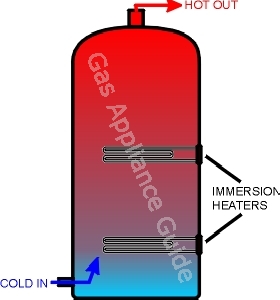 |
Back to top of page |
|
INDIRECT HOT WATER CYLINDER |
| A cylinder is deemed 'indirect'
whenever a heat exchanger is fitted within. This is to say, whenever a heat
source is external to the cylinder and utilises a heat exchanger to impart
heat to the contents of the cylinder the cylinder is deemed to be
'indirect'. A cylinder could be both
'direct' and 'indirect' in certain scenarios. |
| Although heat may be imparted to the cylinder by a heat exchanger
located internally, the heat source is actually remote - such as a gas
boiler, solar panel, heat pump, wood burning stove, Aga etc etc. It is therefore deemed
that such a cylinder is 'Indirect'. Indirect
cylinders may be fitted with immersion heaters as a supplementary 'direct' heat source
but the cylinder is still deemed to be 'Indirect'.
An indirect cylinder may have more than one
heat exchanger (also referred to a a coil) depending on the number of remote
heat sources feeding the cylinder. (i.e. 1 x boiler coil and 1 x solar
coil = twin coil indirect cylinder, or, 1 x boiler, 1 x AGA and 1 x
solar = triple coil indirect.)
The term 'indirect' may apply to a vented cylinder, an unvented cylinder or
a thermal store. It simply refers to an external heat source heating the
cylinder via a heat exchanger.
An Immersion heater boss may be
fitted through the top of the cylinder. You should specify your requirement.
Immersion heater elements are not normally
fitted or included in the price of a cylinder and should be specified if
required. |
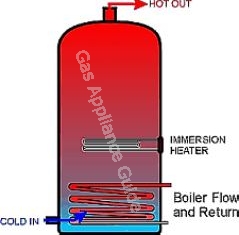 |
|
|
Back to top of page |
|
COMBINATION HOT WATER CYLINDERS |
| A gravity-fed household copper cylinder is
typically supplied from a tank sited above the cylinder - often
located in the loft. This height of this water store (also referred to as a
'cistern' or 'header tank') is what creates the pressure in a gravity water
system. The higher the header tank the greater the 'head' of
water and hence the higher the gravity pressure when measured at the outlet
point. (Also refer to Section on
Grades of Cylinder).
Pressure in a gravity system varies throughout
as the height differential between the header tank and the outlet point
varies. Example: A 10m head of water will create 1 bar of pressure at the
outlet. Using this simple formula you can calculate the approximate pressure
at any outlet by measuring the distance from the outlet point to the header
tank above. You might begin to appreciate why gravity systems are often
referred to a 'low pressure' systems as it is most unlikely that 10m is
anywhere near achievable in most domestic properties. |
|
Where the property is unable to accommodate a header tank (for example in an
apartment or flat) the header can be accommodated literally on top of the
cylinder and built into the unit. The cylinder therefore combines the
'header' and the 'storage' elements and becomes a COMBINATION cylinder. Note: The output water pressure from a
combination cylinder is often poor due to the small distance (head) between the
header section and the outlet point (i.e. A tap). This can be exacerbated when
supplying hot water to a shower outlet when the height of the cylinder
header section and a wall mounted shower handset can be virtually the same -
resulting in zero head and therefore no pressure.
Combination Cylinders may be Direct, Indirect or Economy
7. They simply combine the header function.
Thermal stores may also be configured to be
'combination type' but for a very different reason. Please refer to
'Thermal Store section' for further info.
Immersion heater elements are not normally fitted
or included in the price of a cylinder and should be specified if required. |
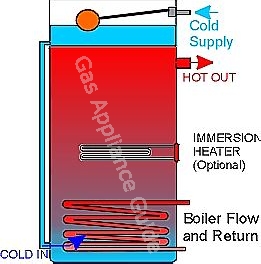 |
Back to top of page |
| SOLAR
HOT WATER CYLINDERS |
| A 'solar cylinder' is a hot
water cylinder that has been configured
to accept 'wet' solar energy. To
explain, there are essentially two types of energy we try to harvest
domestically from the sun - radiant energy (the warmth from the sun) and
photovoltaic (using the light - also referred to a 'pv'). The latter is
where sunlight is converted to electricity. The resulting electrical energy
can be utilised in numerous ways and is therefore not exclusive to the
production of hot water. The former (the radiant energy) is typically
captured by 'wet' solar panels - so named because they contain and utilise a
fluid (rather like antifreeze) to capture and transport the gathered energy.
Although pv energy can of course be use to
heat a cylinder of water with electrical immersion heaters, no special
modifications need to be made to a standard cylinder to accommodate an
electrical immersion heater - a fairly standard feature. To store solar
energy on a 'wet' system is however somewhat more complex and requires a
cylinder to be equipped with a 'solar coil' in order that energy may be
imparted to the cylinder contents. |
| A solar coil is usually located at the very
bottom of a cylinder. Although 'free', solar energy is not as vigorous an
input as say that of a gas boiler so is generally regarded as a low grade
heat source. By placing the heat exchanger at the bottom, energy when
available is percolated throughout the entire cylinder through a high
efficiency coil with a large surface area that facilitates maximum heat
transfer. For the discerning, the
presence of a solar coil in a cylinder facilitates the future addition of a
wet solar system even if the necessary hardware is not immediately
available. Known as 'future-proofing' this is becoming popular (and arguably
logical) as it saves major disruption and further expense by having to
change the water storage cylinder when solar collectors are eventually
introduced to the system.
Solar coils can be fitted in most types of
cylinder (vented, unvented and thermal store) at the time of manufacture. It
is not however a feature that can be retrofitted or bought as an accessory.
Also see:
|
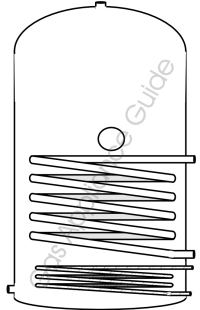 |
Back to top of page |
| ECONOMY 7
hot water Cylinders |
| An Economy 7 cylinder is
designed to exploit 'off-peak' electricity - typically available throughout
the night. Because you are heating
your cylinder overnight it is important to not to loose the stored heat.
Economy 7 cylinders are therefore fitted with an extra thick jacket of
insulation to minimise standing heat loss.
Economy 7 (or indeed Economy 10 where
available) cylinders usually have two heating elements. The lower element
energises as the economy tariff becomes available (via an off-peak switching
device). This heater heats the whole cylinder over several hours - taking
longer because it heats the entire volume. The upper heater is normally used
as a 'boost' element providing a quicker response because it only heats
water at the top of the cylinder and is manually energised when required.
Economy 7 cylinders are available as direct
and
indirect
models of 'cylinder' type or 'combination' type.
|
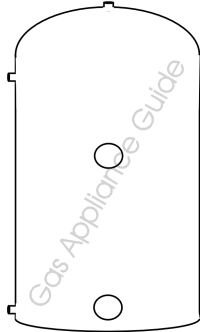 |
Back to
top of page |
| |
|
Configuring or Specifying a hot water cylinder to your own design |
| Never buy a hot water cylinder
believing it to be a 'standard' configuration. Different manufacturers and
indeed different areas of the UK have their own interpretation of what
'standard' means. For example,
cylinders made in Yorkshire by one manufacturer might fit 1" bosses as
connections with boiler connections to the right and cold feed to the left,
whereas another made in Hampshire might use compression fittings and have
connections the opposite way round! Try replacing one for the other and you
may have your work cut out! |
| It doesn't pay to be complacent. This is
especially important if you are replacing an existing cylinder. The one you
take out might have been made to special order thereby facilitating pipe
connections in an awkward installation. Or worse still, the last plumber
didn't think the original job through well enough which meant a difficult
install and even more difficult replacement.
Part of the service we offer is to supply a
cylinder with connections (tappings) configured to your requirement. This is
a fairly simple process and make life so much easier when it comes to
retrofit.
Simply use our
online form to sketch
your requirement and post, fax or email it to us.
Help is always at hand. Simply
call us for assistance if the going gets
confusing or you wish to discuss matters in detail. |
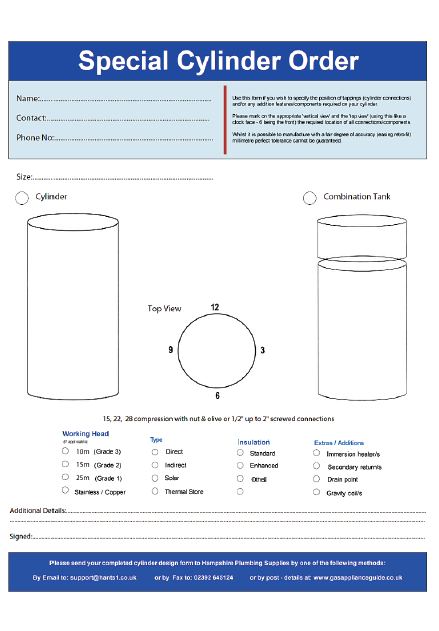 |
Back to top of page |
| Grades of
gravity hot water cylinder |
| Gravity hot water cylinders are available in three
grades. The grades refer to the pressure of water they can withstand from the
header tank (the pressure created by the height of the header tank above the
cylinder).
In simple terms, this translates to
the gauge (thickness) of copper used in construction. Do not confuse a
gravity
cylinder with mains pressure or unvented cylinders. Connection of mains
pressure water to any cylinder designed for a gravity feed can be extremely
dangerous. |
Grade 1 - Can withstand a
25 metre head of water |
| Grade 2 - Can withstand a 15 metre
head of water |
| Grade 3 - Can withstand a 10 metre
head of water It is possible to supply a gravity
cylinder that will withstand a 31 metre head. This is achieved by doming the
bottom of the cylinder. These cylinders sit in a ring mount. Please specify
the working head of the system into which the cylinder will be installed.
A normal domestic cylinder is
usually a Grade 3. (All prices quoted on this website refer to Grade 3
cylinders unless otherwise stated) |